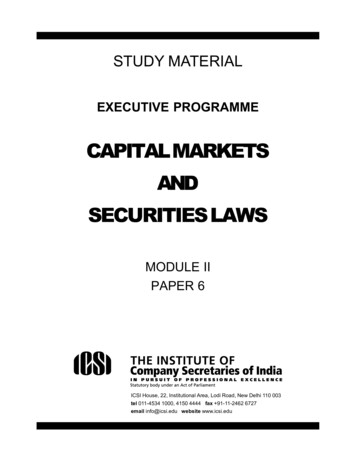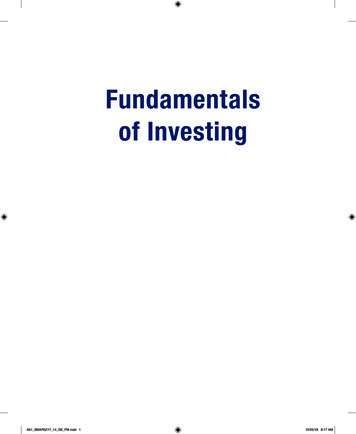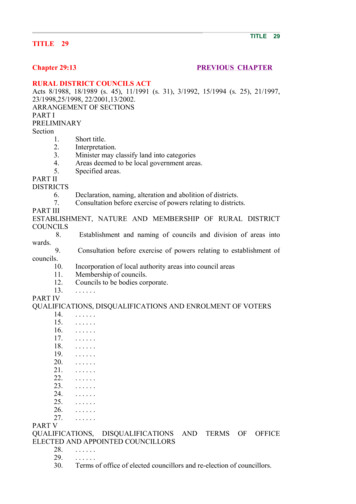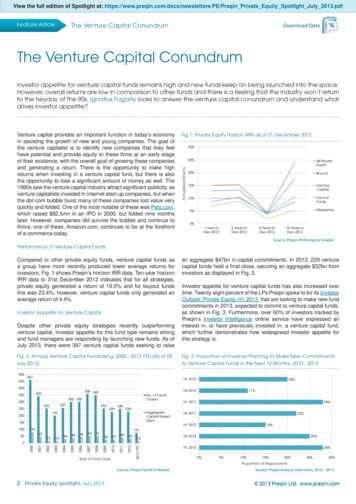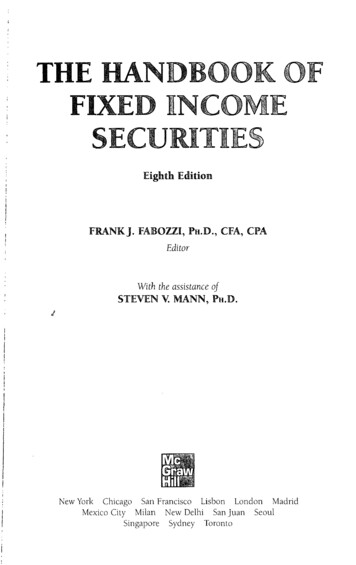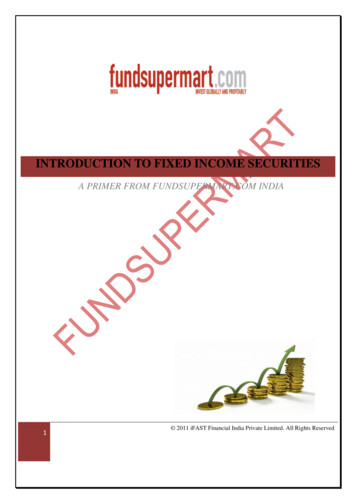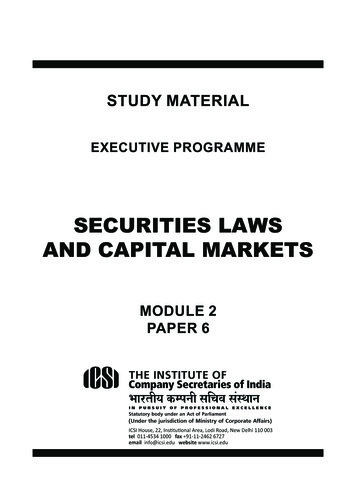
Transcription
STUDY MATERIALEXECUTIVE PROGRAMMESECURITIES LAWSAND CAPITAL MARKETSMODULE 2PAPER 6i
THE INSTITUTE OF COMPANY SECRETARIES OF INDIATIMING OF HEADQUARTERSMonday to FridayOffice Timings – 9.00 A.M. to 5.30 P.M.Public Dealing TimingsWithout financial transactions – 9.30 A.M. to 5.00 P.M.With financial transactions – 9.30 A.M. to 4.00 P.M.Phones011-41504444, fo@icsi.eduLaser Typesetting by AArushi Graphics, Prashant Vihar, New Delhi, andPrinted at H T Media/February 2020ii
EXECUTIVE PROGRAMMESECURITIES LAWS AND CAPITAL MARKETSThe securities markets are vital to the growth, development and strength of market economies andthe maturity of an economy are decided based on the robustness of securities market of an economy.Considering that the Securities market is the core area of practice for the Company Secretaries, itbecomes very important for the professionals to be fully aware of various laws and regulations, both forpractice and guiding the Board of Directors on securities laws related matters. The securities market isgoverned by various regulations enacted in the course of time by the competent legislative body andregulating bodies. This study is divided into two Parts, Part I deals with Securities Laws and Part IIdeals with Capital Market & Intermediaries.Part I of the Study provides an in depth analysis of the legal principles applicable to listed companies inaddition to the Companies Act, 2013. The Regulatory Body Securities Exchange Board of India (SEBI)having extended SEBI’s jurisdiction over corporates in the issuance of capital and transfer of securities,during the course of time has come out with several regulations for smooth functioning of the market,thereby also giving paramount importance to the stakeholders. Therefore, this study discusses variouslegislative and regulatory guidance such as Securities Contracts (Regulation) Act, 1956, DepositoriesAct, 1996, SEBI (Issue of Capital and Disclosure Requirements) Regulations, 2018, SEBI (ListingObligations and Disclosure Requirements) Regulations, 2015, SEBI (Prohibition of Insider Trading)Regulations, 2015, etc.Part II of the study deals with analyses of the secondary market or the capital market, which is the bridgebetween the investors and the corporates. There are several intermediaries and institutions involvedin dealing with the capital market. SEBI has also jurisdiction over all such intermediaries and personsassociated with the securities market. In connection with the same, SEBI has regulated their functioningthrough various regulations, which have been discussed in this part.In the era of plethora of legislations, rules, and regulations, a Company Secretary professional is expectedto be well aware of these rules and principles, as these compliances make the functioning of the marketssmooth while violations leads to severe penalties.This study material is published to aid the students in preparing the paper on Securities Laws andCapital Markets for Executive Programme. It is part of the educational kit and takes the students stepby step through each phase of preparation emphasizing key concepts, principles, legal fundamentalsand procedures. Company Secretaryship being a professional course, the examination standardsare set very high, with focus on knowledge of concepts, their application, procedures and case laws,for which sole reliance on the contents of this study material may not be enough. This study materialmay, therefore, be regarded as the basic material and must be read alongwith the Bare Acts, Rules,Regulations, Case Law.The legislative changes made upto December, 2019 have been incorporated in the study material. Thestudents to be conversant with the amendments to the laws made upto six months preceding the date ofexamination. It may happen that some developments might have taken place during the printing of thestudy material and its supply to the students. The students are therefore advised to refer to the updationsat the Regulator’s website, Supplement relevant for the subject issued by ICSI and ICSI Journal CharteredSecretary and other publications for updation of study material.iii
In the event of any doubt, students may write to the Directorate of Academics of the Institute for clarificationat academics@icsi.edu.Although due care has been taken in publishing this study material, the possibility of errors, omissionsand/or discrepancies cannot be ruled out. This publication is released with an understanding that theInstitute shall not be responsible for any errors, omissions and/or discrepancies or any action taken inthat behalf.Should there be any discrepancy, error or omission noted in the study material, the Institute shall be obligedif the same is brought to its notice for issue of corrigendum in the e-bulletin ‘Student Company Secretary’.iv
LEGALAND REGULATORY FRAMEWORKLEGAL ANDREGULATORYFRAMEWORKTheandlegalRegulatoryand regulatoryframeworkofofSecuritiesSecurities LawsCapitalMarketin Indiagivenisbelow:The LegalFrameworkLawsandandCapitalMarketsin isIndiagiven below :Legal FrameworkSecurities Contracts(Regulation) Act, 1956Depositories Act, 1996Securities and ExchangeBoard of India Act, 1992Securities Contracts(Regulations) Rules, 1957 Regulations GoverningIssue and Listing ofSecuritiesCircularsMaster CircularsGeneral OrdersGuidelinesRulesRegulations SEBI (Listing Obligations and DisclosureRequirements) Regulations, 2015 SEBI (Share Based Employee Benefits)Regulations, 2014Sweat SEBI (Buy BackRegulations, 2018Of2020Equity)Securities)1992 SEBI (Mutual Funds) Regulations, 1996 SEBI (Substantial Acquisition of Sharesand Takeovers) Regulations, 2011EquityRegulations GoverningIntermediaries SEBI (Registrars to an Issue and ShareTransfer Agents) Regulations, 1993 SEBI (Underwriters) Regulations, 1993 SEBI (Merchant Bankers) Regulations,1992 SEBI (Stock Brokers) Regulations, SEBI (Prohibition of Insider Trading)Regulations, 2015 SEBI (Delisting ofRegulations, 20092018 SEBI (Intermediaries)Regulations, 2008 SEBI (Bankers to an Issue) Regulations,1994 SEBI (Debenture Trustee) Regulations,1993 SEBI (Portfolio Managers) Regulations, SEBI (Issue of Capital and DisclosureRequirements) Regulations, 2018 SEBI (Issue ofRegulations, 2002SEBI (Depositories andParticipants) RegulationsShares) SEBI (Issue and Listing ofSecurities) Regulations, 2008 SEBI(ForeignRegulations, 2019DebtOther RegulationsPortfolioInvestors) SEBI (Ombudsman) Regulations, 2003 SEBI (Prohibition of Fraudulent and UnfairTrade Practices relating to Securities Market)Regulations, 2003 SEBI (Collective InvestmentRegulations, 1999vSchemes)
EXECUTIVE PROGRAMMEModule 2Paper 6SECURITIES LAWS AND CAPITAL MARKETS (MAX MARKS 100)SYLLABUSObjectivePart ITo provide expert knowledge in the legislations, rules and regulations governing theentities listed on the stock exchanges.Part II To provide the basic understanding of the working of capital markets in India.PART I : SECURITIES LAWS (70 MARKS)Detailed Contents1.Securities Contracts (Regulation) Act, 1956 : Objectives of the SCR Act, Rules and Regulationsmade there under; Important Definitions; Recognized Stock Exchange, Clearing Corporation; Publicissue and listing of securities; Rules relating to Public Issue and Listing of Securities under SecuritiesContracts (Regulation) Rules, 1957.2.Securities and Exchange Board of India Act, 1992: Objective; Powers and functions of SEBI;Securities Appellate Tribunal; Penalties and appeals.3.Depositories Act, 1996 : Depository System in India; Role & Functions of Depositories; DepositoryParticipants; Admission of Securities; Dematerialization & Re-materialisation; Depository Process;Inspection and Penalties; Internal Audit and Concurrent Audit of Depository Participants.4.An Overview of SEBI (Issue of Capital and Disclosure Requirements) Regulations, 2009.SEBI (Issue of Capital and Disclosure Requirements) Regulations, 2009 rechristened as SEBI(Issue of Capital and Disclosure Requirements) Regulations, 2018.5.An Overview of SEBI (Listing Obligations and Disclosure Requirements) Regulations, 2015.6.An Overview of SEBI (Substantial Acquisition of Shares and Takeovers) Regulations, 2011.7.SEBI (Buyback of Securities) Regulations, 1998 : Conditions of buy-back; Buy back Methods:Tender Offer, Open Market (Book building and Stock Exchange); General obligations; Penalties.SEBI (Buyback of Securities) Regulations, 1998 rechristened as SEBI (Buyback of Securities)Regulations, 2018.8.SEBI (Delisting of Equity Shares) Regulations, 2009 : Delisting of Equity Shares; Voluntary Delisting;Exit Opportunity; Compulsory Delisting.9.An Overview of SEBI (Share Based Employee Benefits) Regulations, 2014.10.An Overview of SEBI (Issue of Sweat Equity) Regulations, 2002.vi
11.SEBI (Prohibition of Insider Trading) Regulations, 2015 : Unpublished price sensitive information(UPSI); Disclosures; Codes of fair disclosure and conduct; Penalties and Appeals.12.Mutual Funds : Types of Mutual Funds and Schemes; Key players in Mutual Funds: Sponsor, AssetManagement Company, Trustee, Unit holder, Evaluating performance of Mutual funds- Net Asset Value,Expense Ratio, Holding Period Return.13.Collective Investment Schemes : Regulatory Framework; Restrictions on Business Activities;Submission of Information and Documents; Trustees and their Obligations.14.SEBI (Ombudsman) Regulations, 2003 : Procedure for Redressal of Grievances; Implementation ofthe Award; Display of the particulars of the Ombudsman, SCORES, SEBI (Informal Guidance) Scheme,2003.Case Laws, Case Studies & Practical AspectsPART II: CAPITAL MARKET & INTERMEDIARIES (30 MARKS)15.STRUCTURE OF CAPITAL MARKETI.II.Primary Market(a)Capital Market Investment Institutions-Domestic Financial Institutions (DFI), QualifiedInstitutional Buyers (QIB), Foreign Portfolio Investors (FPI), Private Equity, Angel Funds,HNIs, Venture Capital, Pension Funds, Alternative Investment Funds.(b)Capital Market Instruments-Equities, Preference Shares, Shares with Differential VotingRights, Corporate Debt, Non-Convertible Debentures (NCD), Partly, Fully and OptionallyConvertible Debentures, Bonds, Foreign Currency Convertible Bonds (FCCB), ForeignCurrency Exchangeable Bonds (FCEB) Indian Depository Receipts (IDR), Derivatives,Warrants;(c)Aspects of Primary Market- book building, ASBA, Green Shoe Option.Secondary MarketDevelopment of Stock market in India; Stock market & its operations, Trading Mechanism,Block and Bulk deals, Grouping, Basis of Sensex, Nifty; Suspension and Penalties; SurveillanceMechanism; Risk management in Secondary market, Impact of various Policies on Stock Marketssuch as Credit Policy of RBI, Fed Policy, Inflation index, CPI, WPI, etc.16.Securities Market Intermediaries : Primary Market and Secondary Market Intermediaries: Role andFunctions, Merchant Bankers, Stock Brokers, Syndicate Members, Registrars and Transfer Agents,Underwriters, Bankers to an Issue, Portfolio Managers, Debenture Trustees, Investment Advisers,Research Analysts, Market Makers, Credit Rating Agencies; Internal Audit of Intermediaries byCompany Secretary in Practice.Case Laws, Case Studies & Practical Aspects.vii
LESSON WISE SUMMARYSECURITIES LAWS AND CAPITAL MARKETSPART I – SECURITIES LAWSLesson 1 – Securities Contracts (Regulation) Act, 1956Stock Market plays a significant role in the development of Economy. Stock Market facilitates mobilization offunds from small investors and channelizes these resources into various development needs of various sectorsof the economy. The Securities Contracts (Regulation) Act, 1956 (“SCRA”) is an important piece of legislationwhich regulates the stock exchanges and contracts in securities.The SCRA was enacted to prevent undesirable exchanges in securities and to control the working of stockexchange in India. It came into force on February 20, 1957. This Act gives powers to regulate and govern thestock exchanges and their working. There are certain powers which are delegated to SEBI under this Act.The Government of India promulgated the Securities Contracts (Regulations) Rules, 1957 (“SCRR”) for carryinginto effect the objects of the SCRA.The SCRA and SCRR also prescribes the conditions for listing of securities on the stock exchanges. It alsoprovides for amount of public holding required in every public company seeking listing.This lesson will give an insight into the various Powers of Central Government, Stock Exchange and SEBIunder the SCRA Act, the penal provisions, procedures, offences, the procedure for appeal to SAT, Right ofInvestors and various listing and delisting provisions under Securities Contract (Regulations) Rules, 1957 etc.At the end of this lesson, the student will able to understand: Registration of stock exchange(s); Powers of Central Government in various cases; Powers of Recognised Stock Exchange to make rules and bye-laws; Powers of SEBI under SCRA; Clearing Corporation and its functions; Issue of securities to the Public; Delisting of securities from recognised stock exchange; Procedure to file an appeal to Securities appellate tribunal; Various penalties for various offences as prescribed under the Act; and Requirements for listing of securities with recognised stock exchange;Lesson 2 – Securities and Exchange Board of India Act, 1992With an aim to regulate the securities market in India, the Govt. of India set up a regulatory body i.e. Securitiesand Exchange Board of India (‘SEBI’) in 1988. It became an autonomous body by the Government of India on12 April 1992 and given statutory powers in 1992 with SEBI Act, 1992 being passed by the Indian Parliament.The Preamble of the Securities and Exchange Board of India is “to protect the interests of investors in securitiesviii
and to promote the development of, and to regulate the securities market and for matters connected therewithor incidental thereto”.The SEBI Act is the main Act from which several other Rules and Regulations have originated. The Actconstitutes a Board (“the SEBI”) to protect the investors’ interest in securities and to promote the developmentand to regulate the securities market. The SEBI replaces the erstwhile Controller of Capital Issues. The SEBIhas various powers under the Act including to issue various Regulations to better regulate the securities marketand for better investor protection. It governs and regulates the market intermediaries. It has wide powers ofinvestigation, survey, search and seizure, powers to impound documents, take statements on oath, etc. Thus,the powers enshrined in the SEBI are of a very wide amplitude. It also has powers to issue “directions, e.g.,cease and desist” orders, by virtue of which, it can prohibit any person or intermediary from carrying out certainoperations. The Act provides for stringent penalties for different types of offences and violations.The objective of this lesson, is to provide a broader information regarding various powers and functions ofSEBI, various stringent penalties for protecting the interest of investors and and inspection of various regulatedentities, etc. to the students. At the end of this lesson, the student will able to understand : Powers and functions of SEBI; Conditions for offer of collective investment scheme by a company; Investigations procedure by the SEBI; Various penalties imposed by the SEBI for various failures, default, non-disclosure and other offenses; Procedure & Conditions for registration of an intermediaries; and Formation of the Securities Appellant Tribunal, its compositions, tenure, requirements for appeal and itspowers.Lesson 3 – Depositories Act, 1996A Depository is an organization like a Central Bank where the securities of a shareholder are held in theelectronic form at the request of the shareholder through the medium of a Depository Participant. A DP canbe a bank, financial institution, a broker, or any entity eligible as per SEBI norms and is responsible for thefinal transfer of shares from the depository to investors. The investor, at the end of a transaction receives aconfirmation from the depository.In India, there is Depository System for securities trading in which book entry is done electronically and nopaper work is involved. The physical form of securities is extinguished and shares or securities are held in anelectronic form. Before the introduction of the depository system through the Depository Act, 1996, the processof sale, purchase and transfer of securities was a huge problem, and there was no safety at all.The Depositories Act, 1996 provides a legal framework for establishment of depositories to facilitate holding ofsecurities including shares in the demat form (electronic form) and to effect transfer of securities through bookentry. The Act establishes the depository system in India by providing for setting up of one or more depositoriesto enable the investors to hold securities in non-physical form (known as dematerialized form) and to affecttransfer of securities by way of book entries in accounts maintained by the depository.Every depository is required to be registered with SEBI and will have to obtain a Certificate for commencementof business on fulfillment of the prescribed conditions. There are two types of depositories in India, namelyNational Securities Depository Limited (NSDL) and Central Depository Services Limited (CDSL). The functioningof Depository and its constituents in India is primarily governed by the Depository Act 1996, SEBI (Depository& Participant) Regulations, 2018, Bye-laws and business rules of respective depositories.The operational and functional issues relating to depository system have been discussed in this lesson toix
give an idea of the practical implications of various statutory and regulatory provisions. Further, a PractisingCompany Secretary has been recognised by SEBI for various types of Audit of Depository participants.At the end of this lesson, the student will able to understand : Basics of depository and its benefits; Models of depository and its functions; Process of dematerialisation and rematerialisation of securities; Securities which are eligible to be issue in depository mode; The concept of fungibility and rights of depository & beneficial owner; The applicability of SEBI (Depositories and Participants) Regulations, 2018; Audit of depositories i.e., Internal Audit and Concurrent Audit by a Practising Company Secretary; and Audit of Reconciliation of Share Capital by a Practising Company Secretary.Lesson 4 – An Overview of SEBI (Issue of Capital and Disclosure Requirements) Regulations,2018The SEBI (Issue of Capital and Disclosure Requirements) Regulations, 2009 (the ICDR Regulations) werenotified with the objective to bring more clarity to the provisions of the rescinded SEBI DIP Guidelines byremoving the redundant provisions and modifying certain provisions on account of changes necessitated dueto market design.The SEBI in order to align its provisions under ICDR Regulations with the Companies Act, 2013 and alliedregulations, had come with its consultation paper on May, 04, 2018 detailing the suggestive changes undervarious fund raising options by listed issuers. The SEBI constituted a committee named “ICDR Committee”under the chairmanship of Sri Prithvi Haldea in June, 2017 to review the ICDR Regulations which suggestedcertain policy changes in continuation to the same, the SEBI on September, 11, 2018 notified the SEBI (ICDR)Regulations, 2018 effective from the 60th day of its publication in official Gazette. SEBI (ICDR) Regulations,2018, lay down various provisions and procedures for various types of issue including public and rights issue.SEBI’s emphasis on disclosure based regulation has witnessed a proliferation of disclosure norms for varioustypes of capital raising activities by Indian companies. SEBI has gradually expanded the disclosure norms andprospectus requirements, culminating in the presently applicable SEBI ICDR Regulations. It lay down guidelinesrelating to conditions for various kinds of issues including public and rights issue. The ICDR Regulations providedetailed provisions relating to public issue such as conditions relating to an IPO and Further Public Offer (FPO),conditions relating to pricing in public offerings, conditions governing promoter’s contribution, restriction ontransferability of promoter’s contribution, minimum offer to public, reservations, manner of disclosures in offerdocuments, etc.At the end of this lesson, the student will able to understand: Types of Issue; Concept of draft offer document, letter of offer and red herring prospectus; Contribution of promoters in case of Public Issue & exemption from the same; Concept of underwriting, Opening of Public issue & Minimum Subscription; Minimum number of share applications and application money; Pre-issue advertisement & Post issue advertisement;x
Restriction on further issue of capital & Reservation on competitive basis; and Detailed procedure for issue of securities by companies.Lesson 5 – An Overview of SEBI (Listing Obligations and Disclosure Requirements)Regulations, 2015Listing agreement means where the securities are listed on the application of any person in any recognisedstock exchange, such person shall comply with the conditions of the listing agreement with that stock exchange.It is a basic document which is executed between companies and the stock exchange when companies arelisted on the stock exchange. Listing Agreement entered into by listed companies with the stock exchangesprescribes initial and continuous disclosure norms. The modifications to provisions of Listing Agreement areprescribed by SEBI. The Listing Agreement has been modified from time to time to align with the regulatoryrequirements arising out of the dynamic changes in the capital market.With a view to consolidate and streamline the provisions of existing listing agreements for different segments ofthe capital market and to align the provision relating to listed entities with the Companies Act 2013, SEBI hasnotified the SEBI (Listing Obligations and Disclosure Requirements) Regulations, 2015 hereinafter referred as‘Listing Regulations’.The SEBI Listing Regulations lay down the broad principles for periodic disclosures to be given by the listedentities operating in different segments of the capital markets. The Listing Regulations have been structured toprovide ease of reference by consolidating into one single document across various types of securities listedon the Stock Exchanges.This lesson will give an overview of : Obligations of listed entities; Various compliances & disclosures required to be made by the listed entities; Types of Board committee under listing regulations; Concept of Vigil Mechanism and Related Party Transactions; and Role of Company Secretary as a compliance officer as per listing regulations.Lesson 6 – An Overview of SEBI (Substantial Acquisition of Shares and Takeovers)Regulations, 2011One of the most popular modes of corporate expansion is by the acquisition of an existing company. However,when the company being acquired is a listed company, then along with the promoters’ stake, there are a lotof other interests, such as, public shareholders, financial institutions, foreign shareholders, etc. It is essentialthat all these shareholders also get a fair deal in case of an acquisition. To address all such concerns, SEBIhas framed the SEBI (Substantial Acquisition of Shares and Takeover) Regulations,1997 which have evolvedsignificantly over the years and notified the SEBI (Substantial Acquisition of Shares and Takeover) Regulations,2011 (‘SAST Regulations’) repealing the old regulation, providing for Acquisition of shares and takeover of listedcompanies popularly known as “Takeover Code”.Takeover code prescribes a systematic framework for acquisition of stake in listed companies. By these lawsthe regulatory system ensures that the interests of the shareholders of listed companies are not compromisedin case of an acquisition or takeover. It also protect the interests of minority shareholders, which is also afundamental attribute of corporate governance principle.After going through this lesson, the students will have the knowledge about the various procedural aspects oftakeover by an acquirer and target company with respect to acquisitions and takeover. At the end of this lesson,the student will have the conceptual clarity about the following aspects of SEBI Takeover Code:xi
Triggering point while making an open offer by an acquirer; Open offer to the public; Concept of Public announcement i.e., timing of Public announcement & Detailed Public announcement; Procedural compliances related to letter of offer, opening of the offer etc.; Obligations of the acquirer and target company; Various disclosures requirements; Exemptions available to the acquirer in case of open offer; and Practical aspects of takeover.Lesson 7 – SEBI (Buy-Back of Securities) Regulations, 2018Buy-back of securities is a corporate financial strategy which involves capital restructuring and is resortedby companies to achieve the varied objectives of increasing earnings per share, averting hostile takeovers,improving returns to stakeholders and realigning the capital structure.Buy-back of securities, like any other transaction of corporate restructuring, brings into play several issues, bothfinancial and non-financial, and the process of buy-back needs to be structured in a way that all the issues aretaken care of favourably.The concept of buy-back was introduced in the Companies Act, 1956 by the Companies (Amendment) Act,1999 by the insertion of Sections 77A, 77AA and 77B. Consequently, SEBI also issued the SEBI (Buy-Backof Securities) Regulations, 1998 (“Old Regulation”) on 14th November 1998 with an objective of simplyfyingthe language, removing redundant provisions and inconsistencies updating the references to the CompaniesAct, 2013/other new SEBI Regulations and incorporating the relevant circulars, FAQ’s informal guidance inthe regulations, the SEBI notified the SEBI (Buyback of Securities) Regulations, 2018 on September 11, 2018repeal the old Regulation. These regulations are applicable to the buyback of securities of a company listed ona stock exchange. Under the Companies Act, 2013 buyback is governed by sections 68, 69 and 70 and listedcompanies are governed by the SEBI (Buy-Back of Securities) Regulations, 2018.This lesson will give an insight to the students into various methods of buy back available, prohibitions, objectivesand process of buy back etc. At the end of this lesson, the student will able to understand: Methods of buy back of securities; Procedure for buyback of securities from existing or security shareholders, from open market and fromodd-lot holders; Compliances related to extinguishing of bought back securities; and Obligations of the company and Merchant Banker.Lesson 8 – SEBI (Delisting of Equity Shares) Regulations, 2009With the new trends towards regulatory simplification to facilitate growth of businesses, barriers to free entry andexit to companies could ultimately prove to be prohibitive in terms of loss of Capital, resources and expertise.Internationally, stock exchanges do not impose any restriction on de-listing and allow de-listing subject to certainconditions such as minimum notice period for the company, exit offers to investors, etc.Similarly in India, SEBI (Delisting of Equity Shares) Regulations, 2009 (“the delisting regulations”) gives anoption to the listed company to either get itself delisted from all the recognised stock exchanges where it islisted through reverse book building or only from some of the stock exchanges and continue to be listed on theexchanges having nationwide terminals through a simplified process. Additionally, these regulations providexii
simplified procedure for delisting of shares of smaller companies.In order to provide a statutory backing for the delisting framework, the Government has also notified delistingrules under Rule 21 of Securities Contract (Regulations) Rules, 1957 (the SCR Rules) dealing primarily withsubstantive aspect on delisting. The Delisting Regulations deal with the delisting of equity shares exclusively,as against the erstwhile Delisting Guidelines which dealt with securities generally.This lesson will make the student acquainted with the various provisions of delisting, reasons for delisting andthe various requirements to be complied with. At the end of this lesson, the student will able to understand: Agencies involved in delisting process and their Role; Concept of voluntary delisting and its different modes; Comprehensive procedure for delisting of equity shares from all the stock exchanges or few stockexchange; Meaning of small companies and how it can voluntary delist its equity shares; Compulsory delisting of shares and its detailed procedure; and Special powers of the recognised stock exchange in case of delisting of equity shares.Lesson 9 – SEBI (Share Based Employee Benefits) Regulations, 2014 – An OverviewIn this very dynamic era, most of the organisations are faced with a persistent challenge of attracting andretaining talented employees. Equity based compensation or stock based incentive schemes are widely usedby the organisations in India and across the globe for their perceived benefits to both employer and employeesin the long run.The SEBI, in the year 1999, had framed “the SEBI (Employee Stock Option Scheme and Employee StockPurchase Scheme) Guidelines, 1999” (hereinafter “existing guidelines”) which provides for the stock basedincentive schemes to employees. On 28th October, 2014, the SEBI had notified the SEBI (Share BasedEmployee Benefits) Regulations, 2014 (hereinafter “Regulations”) repealing the existing guidelines. TheseRegulations apply to ESOS, ESPS, General Employee Benefit Schemes (GEBS), Retirement Benefit Schemes(RBS) and S
Stock Market facilitates mobilization of funds from small investors and channelizes these resources into various development needs of various sectors of the economy. The Securities Contracts (Regulation) Act, 1956 ("SCRA") is an important piece of legislation which regulates the stock exchanges and contracts in securities. The SCRA was enacted to prevent undesirable exchanges in securities .
